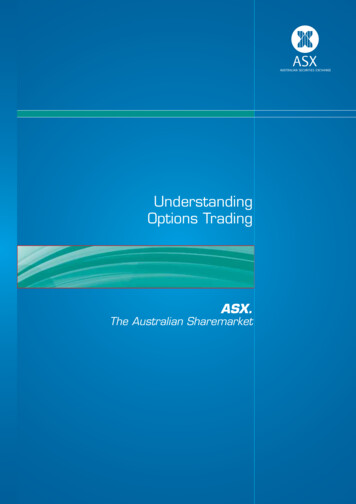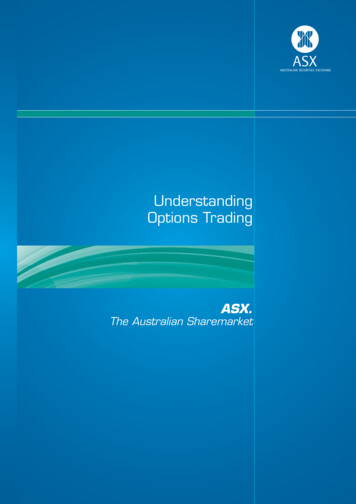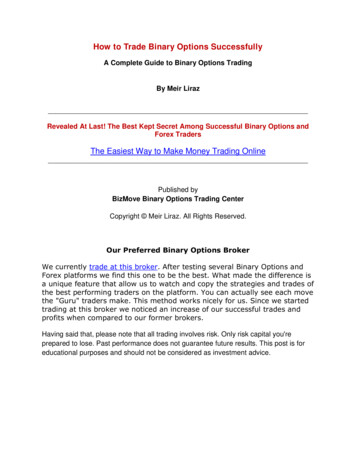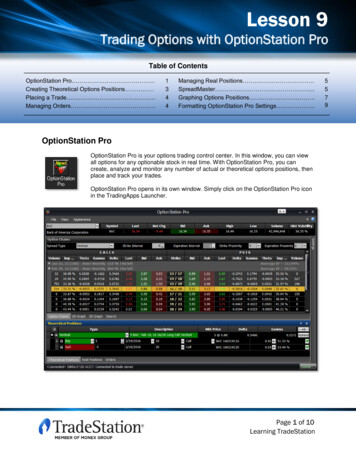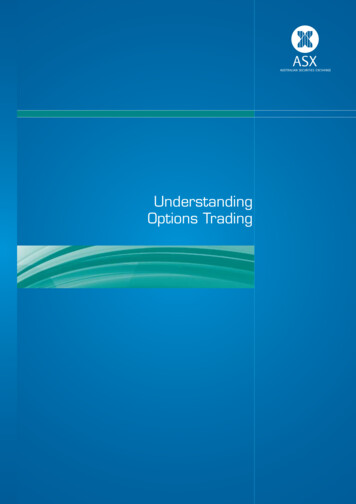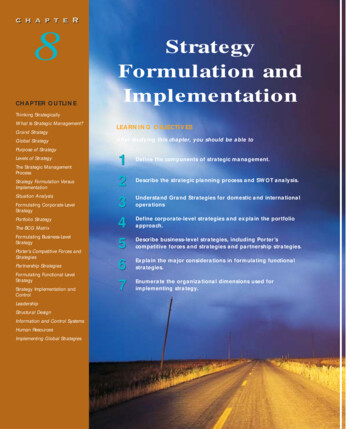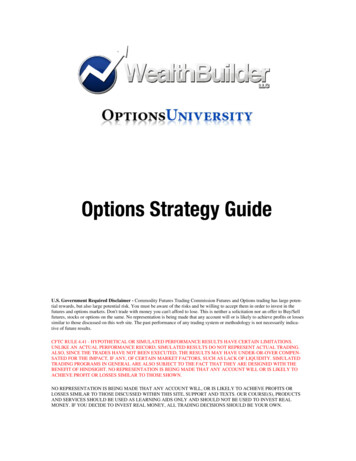
Transcription
Options Strategy GuideU.S. Government Required Disclaimer - Commodity Futures Trading Commission Futures and Options trading has large potential rewards, but also large potential risk. You must be aware of the risks and be willing to accept them in order to invest in thefutures and options markets. Don't trade with money you can't afford to lose. This is neither a solicitation nor an offer to Buy/Sellfutures, stocks or options on the same. No representation is being made that any account will or is likely to achieve profits or lossessimilar to those discussed on this web site. The past performance of any trading system or methodology is not necessarily indicative of future results.CFTC RULE 4.41 - HYPOTHETICAL OR SIMULATED PERFORMANCE RESULTS HAVE CERTAIN LIMITATIONS.UNLIKE AN ACTUAL PERFORMANCE RECORD, SIMULATED RESULTS DO NOT REPRESENT ACTUAL TRADING.ALSO, SINCE THE TRADES HAVE NOT BEEN EXECUTED, THE RESULTS MAY HAVE UNDER-OR-OVER COMPENSATED FOR THE IMPACT, IF ANY, OF CERTAIN MARKET FACTORS, SUCH AS LACK OF LIQUIDITY. SIMULATEDTRADING PROGRAMS IN GENERAL ARE ALSO SUBJECT TO THE FACT THAT THEY ARE DESIGNED WITH THEBENEFIT OF HINDSIGHT. NO REPRESENTATION IS BEING MADE THAT ANY ACCOUNT WILL OR IS LIKELY TOACHIEVE PROFIT OR LOSSES SIMILAR TO THOSE SHOWN.NO REPRESENTATION IS BEING MADE THAT ANY ACCOUNT WILL, OR IS LIKELY TO ACHIEVE PROFITS ORLOSSES SIMILAR TO THOSE DISCUSSED WITHIN THIS SITE, SUPPORT AND TEXTS. OUR COURSE(S), PRODUCTSAND SERVICES SHOULD BE USED AS LEARNING AIDS ONLY AND SHOULD NOT BE USED TO INVEST REALMONEY. IF YOU DECIDE TO INVEST REAL MONEY, ALL TRADING DECISIONS SHOULD BE YOUR OWN.
STRATEGY GUIDEBuy-Write or Covered CallConstruction – Long stock, short one call for every 100 shares of stock owned.Function – To enhance profitability of stock ownership and to provide limited downsideprotection against adverse stock movement.Bias – Neutral to slightly bullish.When to Use – When you feel the stock will trade up slightly or in a tight range for a periodof time and you plan on holding the stock for longer term.Profit Scenario – If stock rises, profit will be enhanced by premium received. If stockstagnates, you will profit from premium received from call sale.Loss Scenario – If stock trades lower than the point defined by your purchase price minusthe premium received from call sale you will lose dollar for dollar. Call premium received willact as an offset to the loss in the stock.Key Concepts – If stock trades up aggressively, you will only profit up to a stock pricedefined by the strike price plus option price. If the stock continues higher above that point(breakeven), you will incur lost opportunity. Further, if stock closes above strike price, stockwill be called away unless necessary adjustment is made. Philosophically identical to the SellWrite position except in opposite direction. Time decay helps the position.OPTIONS UNIVERSITY - STRATEGY GUIDEPage 2 of 24
Sell -Write or Covered PutConstruction – Short stock, short one put for every 100 shares of stock shorted.Function – To enhance profitability of short stock position and to provide limited protectionagainst adverse stock movement.Bias – Neutral to slightly bearish.When to Use – When you feel the stock will trade slightly down or in a tight range for aperiod of time.Profit Scenario – If stock falls, profit will be enhanced by premium received. If stockstagnates, you will profit from premium received from put sale.Loss Scenario – If stock trades higher than the point defined by your stock sales price plusthe premium received from put sale, you will lose dollar for dollar. Put premium received willact as stock loss offset.Key Concepts – If stock trades down aggressively, you will only profit down to a stock pricedefined by the strike price minus option premium. If the stock continues down below thatpoint (breakeven), you will incur lost opportunity. Further, if stock closes below strike price,stock will be assigned to you unless necessary adjustment is made. Time decay helps theposition. Philosophically identical to Buy-Write except in opposite stock direction.OPTIONS UNIVERSITY - STRATEGY GUIDEPage 3 of 24
Protective PutConstruction – Long stock, long 1 put per every 100 shares of stockFunction – To provide maximum downside protection for long stock position. Long stockinsurance policy.Bias – Bullish but cautiousWhen to use – When wishing to protect profits of long stock position while wishing to retainposition. Also, to protect speculative stock purchases (i.e. purchasing stock on potential chartbreak out from present trading range according to Technical Analysis.Profit Scenario – If stock continues to trade up by more than the amount paid for the puts.Once above that level, position makes dollar for dollar with stock.Loss Scenario - If the stock trades down, loss will be felt until stock reaches point defined byputs strike price minus put price. At that level, position will cease losing. If stock stagnates,loss will equal put price due to decay.Key Concepts – Due to the acquisition of time decay from the long put, the position is bestused for protection of already existing profits, or when a potentially aggressive or explosiveupside move in the near future is a good possibility. Other side of the Sell-Write position.Philosophically identical to the Synthetic Put strategy except for anticipation of stock goingup.OPTIONS UNIVERSITY - STRATEGY GUIDEPage 4 of 24
Synthetic PutConstruction – Short stock, long 1 call per every 100 shares of stockFunction – to provide maximum upside protection for a short stock position. Short stockinsurance policy.Bias – Bearish but cautious.When to use – when wishing to protect profits of short stock position while continuing toretain short position. Also, to protect speculative stock sale (i.e. selling stock on potentialchart break down through support from present trading range according to Technical Analysis.Profit Scenario – If stock continues to trade down by more than the amount paid for thecalls. Once below that level, position makes dollar for dollar with stock.Loss Scenario - If the stock trades up, loss will be felt until stock reaches point defined bycalls strike price plus calls price. At that level, position will cease losing. If stock stagnates,loss will equal call price due to decay.Key Concepts – Due to the acquisition of time decay from the long call, the position is bestused for protection of already existing profits, or when a potentially aggressive or explosivedownside move in the near future is a good possibility. Other side of the Buy-Write trade.Philosophically identical to the Protective Put except for anticipation of stock going down.OPTIONS UNIVERSITY - STRATEGY GUIDEPage 5 of 24
CollarConstruction – Long stock, simultaneously long one out-of-the-money put and short oneout-of-the-money call per every 100 shares of stock owned.Function – Provide no-to-low cost maximum profit protection for a long stock position.Bias - cautious or even short term bearish.When to Use – When you feel that your long stock position may run into a tough period oftime but you want to keep the position.Profit Scenario – Depending on how you set up the collar and the prices of the put and call,you may make a very negligible amount. If the stock trades up, you may make a little.Loss – Depending on how you set up the collar and the prices of the put and call, you maylose a little money. If the stock trades down, you may also lose a little but the collar will limitit to a set amount regardless of how low the stock goes.Key Concepts – Collars are not designed to make money. They are designed to providemaximum downside protection, similar to the protective put, but at a much better price. Thepremium received from the sale of the call will offset the amount paid for the put.OPTIONS UNIVERSITY - STRATEGY GUIDEPage 6 of 24
Bull SpreadConstruction – Long one call while simultaneously short one call with a higher strike in thesame month. Or, short one put while simultaneously long one put with a lower strike in thesame month.Function – Low cost stock directional play which allows you two choices to put on the sametrade. Long Vertical Call Spread or Short Vertical Put Spread.Bias – BullishWhen to use – Use when you feel the stock is likely to rise but not too quickly norexplosively as this strategy has a limited profit potential. Also, when constructed properly,this spread can be used as a premium collection strategy.Profit Scenario – If stock rises, profit will be defined by the increase in value of the longvertical call spread or, in the case of a short vertical put spread, its decrease in value.Loss Scenario – If stock declines, loss will be defined by the decrease in value of the longvertical call spread, or in the case of a short vertical put call spread, its increase in value.Key Concepts – The maximum value of a vertical spread will be equal to the differencebetween the two strikes, therefore both the buyer and the seller will have a limited profit andlimited loss scenario. Depending on which strikes you use, time decay can help or hurt theposition. Thus, some vertical spreads can make money over time even if stock staysstagnant.OPTIONS UNIVERSITY - STRATEGY GUIDEPage 7 of 24
Bear SpreadConstruction – Long one call while simultaneously short one call with a lower strike in thesame month. Or, short one put while simultaneously long one put with a higher strike in thesame month.Function – Low cost stock directional play which allows you two choices to put on the sametrade. Short Vertical Call Spread or Long Vertical Put Spread.Bias – BearishWhen to use – Use when you feel the stock is likely to decline but not too quickly norexplosively as this strategy has a limited profit potential. Also, when constructed properly,this spread can be used as a premium collection strategy.Profit Scenario – If stock declines, profit will be defined by the decrease in value of theshort vertical call spread or, in the case of a long vertical put spread, its increase in value.Loss Scenario – If the stock rises, loss will be defined by the increase in value of the shortvertical call spread, or, in the case of a long vertical put spread, its decrease in value.Key Concepts – The maximum value of a vertical spread will be equal to the differencebetween the two strikes, therefore both the buyer and the seller will have a limited profit andlimited loss scenario. Depending on which strikes you use, time decay can help or hurt theposition. Thus, some vertical spreads can make money over time even if stock staysstagnant.OPTIONS UNIVERSITY - STRATEGY GUIDEPage 8 of 24
Time SpreadConstruction – Long one call in a further out month while simultaneously short one call withthe same strike but in a closer expiration month.Function – To collect time premium by taking advantage of options non-linear rate of decay.Bias – Neutral.When to use – Best used during stagnant periods in order to collect premiums due to timedecay. Unlike other premium collection strategies, the time spread offers a limited lossscenario in both directions.Profit Scenario – If the stock remains stagnant, the position will profit by the nearer monthoption (which you are short) decaying at a faster rate than the further out month option(which you are long). When this occurs, the spread will widen thus creating a profit. Profitcan also be attained if implied volatility increases.Loss Scenario – If the stock moves away from the strike by either rising or falling, thespread will tighten, thus losing value and creating a loss.Key Concepts – Time spreads are best done in at-the-money options where the extrinsicvalue is the highest which accentuates the rate of decay. Best results are found in stocks thatare in a stagnant period as stock movement away from the strike will lead to losses.OPTIONS UNIVERSITY - STRATEGY GUIDEPage 9 of 24
Long StraddleConstruction – Long one call and one put with the same strike price, in the same expirationmonth and in a one to one ratio. Strike price used is normally at-the-money.Function – To take advantage of large potential stock movements in either direction or if youanticipate an upward movement in implied volatility.Bias – Volatile in either direction.When to Use – Normally around news release time (i.e. earnings) when you feel that thenews can effect the stock aggressively but aren’t sure in which direction. Also, good to usewhen you feel implied volatility is likely to increase sharply.Profit Scenario – Profit will be obtained in a dollar for dollar fashion if the stock closesoutside of the parameters of the breakevens set forth by first adding the strike price to theamount paid for the straddle then subtracting the amount paid for the straddle from the strikeprice. Theoretically, unlimited potential reward.Loss Scenario – Loss occurs if stock closes between break-even points as defined above.Maximum loss occurs if stock closes directly at the strike and lessons as stock closes closer toeither of the breakeven points. Maximum loss is limited to price paid for straddle.Key Concept – Because of large decay associated with this position, time sensitivity iscritical. Once anticipated movement occurs, it is critical to close down position in order tosecure profit and eliminate further risk of substantial decay.OPTIONS UNIVERSITY - STRATEGY GUIDEPage 10 of 24
Short StraddleConstruction – Short one call and short one put with the same strike price, in the sameexpiration month in a one to one ratio. Strike price used is normally at-the-moneyFunction – To take advantage of a stock entering a stagnant or low volatility trading range.Bias – StagnantWhen to Use – Normally around a time away from expected news releases (i.e. earnings)when you feel that the lack news can lead to a period of stagnation or lack of movement ofthe stock without directional bias. Also, good to use when you feel implied volatility is likely todecrease sharply.
decay. Unlike other premium collection strategies, the time spread offers a limited loss scenario in both directions. Profit Scenario – If the stock remains stagnant, the position will profit by the nearer month option (which you are short) decaying at a faster rate than the further out month option (which you are long). When this occurs, the spread will widen thus creating a profit. Profit
